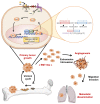SHH Signaling Pathway Drives Pediatric Bone Sarcoma Progression
- PMID: 32110934
- PMCID: PMC7140443
- DOI: 10.3390/cells9030536
SHH Signaling Pathway Drives Pediatric Bone Sarcoma Progression
Abstract
Primary bone tumors can be divided into two classes, benign and malignant. Among the latter group, osteosarcoma and Ewing sarcoma are the most prevalent malignant primary bone tumors in children and adolescents. Despite intensive efforts to improve treatments, almost 40% of patients succumb to the disease. Specifically, the clinical outcome for metastatic osteosarcoma or Ewing sarcoma remains poor; less than 30% of patients who present metastases will survive 5 years after initial diagnosis. One common and specific point of these bone tumors is their ability to deregulate bone homeostasis and remodeling and divert them to their benefit. Over the past years, considerable interest in the Sonic Hedgehog (SHH) pathway has taken place within the cancer research community. The activation of this SHH cascade can be done through different ways and, schematically, two pathways can be described, the canonical and the non-canonical. This review discusses the current knowledge about the involvement of the SHH signaling pathway in skeletal development, pediatric bone sarcoma progression and the related therapeutic options that may be possible for these tumors.
Keywords: Ewing sarcoma; Gli; Sonic Hedgehog; osteosarcoma; skeletal development.
Conflict of interest statement
The authors declare no conflict of interest.
Figures




References
Publication types
MeSH terms
Substances
LinkOut - more resources
Full Text Sources
Other Literature Sources
Medical
Miscellaneous

